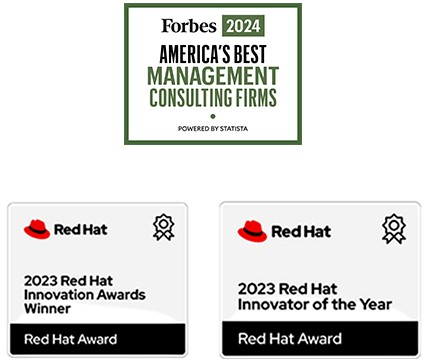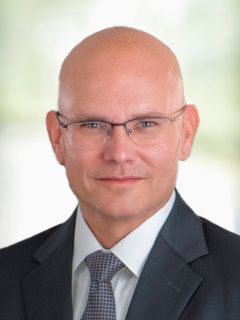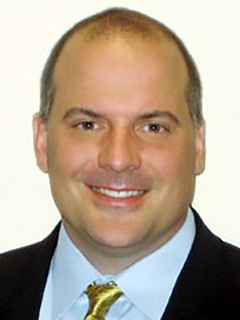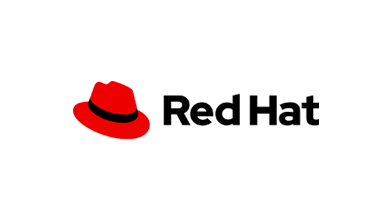Transcripts
The KPMG | Red Hat Alliance
Driven by innovation.
Built on collaboration.
Committed to creating greater value for our joint clients in traditional and cutting-edge ways.
So, you can succeed faster – on your cloud transformation journey.
By combining industry and domain expertise with Red Hat software we deliver client innovation.
Our joint-tested technology solutions help you to: Spend less money maintaining legacy platforms
· Modernize financial services architecture, with
· Red Hat OpenShift
Connect disparate systems to share information seamlessly
· KRIS (KPMG Resource Integration Suite)
· Red Hat Fuse
· Red Hat 3 Scale
· Red Hat Open Shift
· Red Hat Integration
Gives you more time through automation
· Accelerate end of life remediation
· Red Hat Ansible Automation Platform
· Red Hat Enterprise Linux
Free yourself from virtualization chains
· Migrate to OpenShift virtualization
· Red Hat OpenShift virtualization
And keep your auditors happy with automated controls
· Automate controls observability
· Red Hat Ansible Automation Platform
So, you can remain competitive.
Delivering benefits that:
• Give you the flexibility and portability by avoiding vendor lock-in
• Better security throughout the application life cycle
• Lower operational costs
• Speed up application development and delivery.
• Deliver frequent and responsible updates to quicky.
• And with higher availability of application delivery, you can scale more rapidly.
KPMG and Red Hat
A winning combination that helps you meet your business imperatives, manage complex environments, and succeed faster.
The KPMG and Red Hat Alliance short
Driven by innovation.
So you can succeed faster on your cloud transformation journey.
KPMG and Red Hat software: A winning combination.
Better together.
KPMG and Red Hat – State and Local Government
WK
Wyatt Kash
0:07
State and local transportation agencies find themselves at a crossroads, tasked with refreshing and replacing aging transportation infrastructures that have reached the end of their service life while merging onto the Digital Highway of a modernized IT infrastructure. I want to cash with scoop newsgroup, and here to talk about how agencies can modernize their infrastructure, integrate connected and automated technology and meet goals for citizen safety and services are Tony Hernandez principal for KPMG. And Kevin tonx, technology advisor and application architect for Red Hat. Gentlemen, thank you so much for joining us. And, Tony, I'd like to start with you. transportation agencies have evolving strategic priorities right, including safety, mobility, equity and sustainability. How do these shifting priorities impact decision making about infrastructure modernization? And how does technology enable those goals?
TH
Tony Hernandez
1:06
Banks? Wyatt, yeah, you know, when you think about it, most of our transportation infrastructure, as we know, it, was built half a century ago. And so much of it is is, is due to be refreshed anyway, it's reaching the end of its service life. And like just about everything else in our lives, you know, all of the technology associated with a lot of our infrastructure has been evolving over the last 50 years. So, you know, a good case in point earlier, earlier this summer, we had, you know, a major incident on a on a on a north south artery, interstate 95, on the east coast of the US, that had four lanes of essentially a bridge collapse. And they were able to get all four lanes open within 12 days, which would have been unthinkable 10 or 15 years ago. And so when we think about how much the technology has evolved, just around the infrastructure, we also have to be thinking about how much the technology has evolved around all of the, I'll say, devices that are dependent upon that infrastructure. So when we're talking about all of the devices that are doing traffic monitoring, that could be sensors, and video or weather, moderate, or weather monitoring. And then and then also think about the vehicles themselves, right, as the vehicles continue to evolve, the amount of data that's coming off of connected and autonomous vehicles and, and trucks is is going to be it's going to be staggering, really staggering. And so as we're considering refreshing our infrastructure, we have to be thinking about refreshing the infrastructure in such a way that it's able to meet all of these new tech technical demands, and not just the demands for today. But to have an infrastructure that's flexible and scalable enough that we have to use this infrastructure for the next, you know, 20 to 30 years. So we have to be thinking ahead for the infrastructure as well.
WK
Wyatt Kash
3:25
Well, and, Tony, just a follow on that. And based on your experience, working with many agencies, can you provide insights into practical strategies that transportation agencies in particular can adopt as they modernize their infrastructure and do so faster?
TH
Tony Hernandez
3:40
Yeah, so the first, the first recommendation would be that when an organization is in its preliminary design phase, right, and it's pre project phases, where it's gathering requirements, it needs to be thinking about these requirements much, much earlier. At this point, they're trying to fit some of the the technical requirements in almost as an afterthought. And then they're not fully able to address kind of all of the other strategic priorities that they're supposed to be doing with this infrastructure, you know, how are they? How are they able to leverage the infrastructure so that they're able to meet their safety requirements or their congestion management requirements, and then taking it a step further. So thinking about what's happening 10 years from now, you'll see that there's a huge push for, for example, when area around funding, right, this infrastructure is very, very expensive, right? How, how are they going to be able to pay for it? And so, you know, with a modern infrastructure, there are actually opportunities, for example, to monetize some of that infrastructure. There's the ability to monetize some of some of the data that they're collecting. And, and to be able to provide additional information around around congestion. And, and also, there's the ability to, to leverage the physical infrastructure, there's so much land and so much space, for example, when you think about roadways and the right aways, that that they could be doing things like installing solar, for example. And then and then adding using that revenue to help perpetuate the the ability to operate and maintain that that infrastructure.
WK
Wyatt Kash
5:41
Well, Kevin, love to bring you in here. Could you provide any additional examples of a successful modernization project, you know, highlighting the the journey and the challenges, and really the technology technological strategies applied in modernizing their systems to, again, as we were talking about support, enhance customer awareness, safety, and also analytics?
KT
Kevin Tunks
6:04
Yeah, no, thank you. And thanks for the chance to talk about such an important timely topic. Your red hat has been involved with a lot of different organizations and transportation monetization over the last really decade and a half in particular, that information is because just what you were talking about, it is spreading across these different areas in distributed forms in ways that hadn't before. So one example of that is a large Metropolitan Railway group in the Northeast that we've been working with, they really had their initial problem space that they needed to solve was tracking enterprise assets, the tools, the machinery, the specialized capability, that they can use to maintain and repair roadways, bridges, tunnels, all across the entire spectrum. Because of the expense associated with that specialized equipment, they needed to know that they could track where it was physically put it into the right spaces at the right time, so that they could minimize any downtime. So that was really kind of the start point where technology played a really critical role. Especially mobile technologies played a really critical role in tracking and maintaining all of those disparate pieces. From there, it really moved down into a more traditional IT space. There were sensors on railway sensors, on buses, sensors, on bridges, and other infrastructure, all of that information on really a messaging backbone needed to be collected, and then moved through the system so that they could begin doing more analytics activities associated positive train control types, activities, things that really tangibly improved safety and awareness across the entire spectrum of both build devices, and headquarters assets that could be that they could take advantage of what we ended up doing was really spending time building out the components and infrastructures using open standards, to bring that messaging in from the field from the sensors on the tracks and trains and buses, pulling that in through corporate it on prem type activities that they had built up and leveraging what they had already invested in. But then extending that into a hybrid cloud model, where they were able to move that to the cloud to start doing data analytics and data sharing and data hosting and in capabilities that they had not been able to do before. And that really unlocked a lot of new insights very quickly for them, that they could improve rider experience, improve employee experience, and ultimately have a better overall experience of executing their fundamental missions, because the technology just increased the speed with which all that information was available.
WK
Wyatt Kash
9:14
Well, you raised a really important point, and that is a role that sensors feeding data is become so essential to modernizing today's transportation system. So that's a lot of data. And it raises the question, you know, security and compliance are essential aspects of modernizing those systems and the transportation infrastructure at large. So given the increasing importance of cybersecurity, and how do public private partnerships contribute to it enhancing security measures, while also maintaining transparency and accountability?
KT
Kevin Tunks
9:49
Yeah, it's a really fundamental piece, right is especially as we move from just sort of back office type systems, things that are inside of the mode of have historic enterprise environments, to now we're sharing information really, really seamlessly between individuals mobile devices into, you know, other corporate assets that are bringing that information. And a lot of that information has to be managed with really strict compliance rules around not only the safety of that information, because we're talking about critical infrastructure and assets, but also for the privacy of the individuals who are sharing that information back and forth. So having open standards, having environments that are really built around secure technologies in the first place, immutable systems that can deploy to distributed areas, right pushing, pushing content all the way out to the edge, maintaining the updates, and patching in all of those systems that are spread out throughout the entire enterprise and into the field. Having that hygiene, and that regularized process goes a very long way to maintaining those security standards, and then being able to adapt to new threats, because inevitably, there's always new threats that come up that come online, the more you have good visibility, the more you have automation and controls to be able to manage those environments, the better you're able to meet those criteria, but also continue to adapt to them over time.
WK
Wyatt Kash
11:30
Well, and I'd like to direct this last question to both of you, what recommendations or lessons would you offer to agency leaders, you know, striving to accelerate their efforts amid so many challenges that they face? And the fact that technology is evolving? So quickly? Tony, maybe you could take that one first.
TH
Tony Hernandez
11:49
Sure why Yeah, thanks. So if you think about where we are today, right, and the amount of data that we are just currently collecting, you really need to focus on a solution that is both modular and scalable, scalable, so that we're able to meet not just the demands of today, but we know that those demands are going to increase significantly over time. So the ability to be able to scale a solution without necessarily having to, to replace the entire thing is going to be is going to be very important. And then understanding that this infrastructure has to be in place for the next 2030 years, you know, you want to have some modularity to it, so that as different points in the solution continue to evolve, you can replace those individual points, those individual modules without having to replace the entire thing all at once. So, you know, thinking ahead and thinking about modularity and and scalability are going to be critical. And Kevin?
KT
Kevin Tunks
13:06
Yeah, I think the modularity, scalability, and I'll even throw the additional term of adaptiveness to it, because it and Tony really brought this up to these environments have to be maintained and adapt and become adaptive over a long period of time. There's no way to predict with with precision, what the requirements are going to be 2030 years into the future. But knowing that you can build these technologies into your core platforms, following good standards, following open standards, you've got the ability to say that piece of messaging framework, that piece of AI that piece of, of of security, technology, all of those can adapt with you, as new things come come to bear, you have to rip and replace all of the technology out of a solution in order to help it to adapt to connected autonomous vehicles to roadway sensors, for your enterprise asset oriented organization that are that are doing the maintenance and repair, you can incrementally add those with that technology backbone that really sticks to open principles, API based distributed technology platforms. In Luckily, there's partners that can help you with that there's there's folks like Tony, like myself, like others that are in our organizations that really know how to help you build that in so that you're not locking yourself in too early in the process.
WK
Wyatt Kash
14:43
Well, Tony Hernandez and Kevin Tunxis, thank you so much for joining us and sharing your insights about ways to incorporate modern technology into modern public infrastructure, all for the benefit of public safety and better public service. So thank you so much for sharing all that you have today
TH
Tony Hernandez
15:02
You're welcome Wyatt thank you thank you so much










